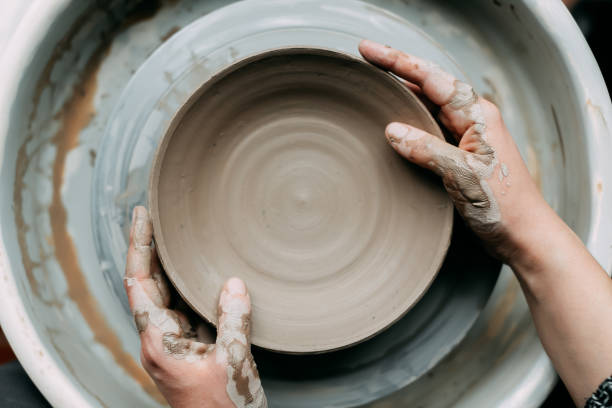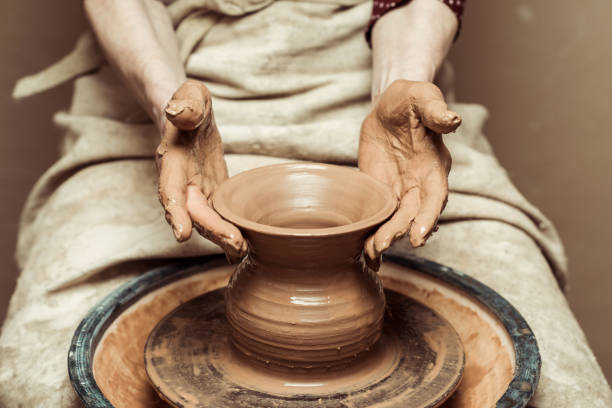Pottery wheels are used to throw clay into shapes. They can be found in most pottery studios and sometimes even in people’s homes.
Cheaper pottery wheels tend to have a lower spec than more expensive ones. This can affect their power and torque.
It’s important to test a wheel before buying it. This way you can make sure that it’s humming and doesn’t have any issues.

Buying a Pottery Wheel
Pottery wheels are a big investment, but they are essential for pottery-making. If you’re in the market for a used one, here are a few things to keep in mind:
First, make sure that the wheel is working properly. If it’s making a smooth, gentle, and consistent humming noise, that’s a good sign. However, if you hear crunching, grinding, or squeaking sounds, those could be a sign that the main bearing on the shaft has corroded and needs replacement.
Also, check the wheel’s weight. Depending on your studio space and how much clay you plan on using, you might need a light or heavy wheel. It’s also important to note if the wheel has a splash pan (usually a plastic or metal tray positioned under and around the wheel head), as this is necessary for catching water while throwing.
The final thing to look for is the speed of the wheel’s motor. The faster the motor, the more clay the wheel can handle. This is a crucial factor to consider, especially for new potters who may want to take on bigger projects in the future.
You can usually find a good deal on a pottery wheel if you buy it from pottery supply stores. Many local community centers will sell their used ones, and you can often find them at auctions hosted by public schools.
How to Use a Pottery Wheel
A potter’s wheel is a circular metal disc that spins while the potter shapes clay into vessels. It can be powered manually or by an electric motor. It is usually mounted on a wooden base that attaches to the wheel head, and it has a plastic pan that sits beneath and around it to catch any water, clay or slip as it’s being formed.
The first thing the potter has to do is center the clay on the wheel by pushing it up into a cone shape with one hand and then flattening it with the other. Then the potter can begin to sculpt the clay into various forms such as cups, bowls and plates.
Once the clay is shaped it is allowed to dry to a leather hard state. This allows the potter to finish and trim the piece.
When the clay is ready to be trimmed, the potter needs to slow down the wheel to about 80% of full speed. They then put their anchor hand, which is the non-primary hand, on the clay and their other hand in a karate chop position on top of it.
The potter then moves the modeling tool upward to start cutting away the excess clay. This is done very carefully as if too much pressure is applied, the clay can stretch and misshape.

Pottery Wheel Maintenance
Whether you’re a long-time potter or just starting out, there will likely be mechanical issues that arise from time to time. The good news is that most of these issues are easy to fix, and can be addressed with a little bit of troubleshooting and regular maintenance.
A common issue is that the pottery wheel makes loud and annoying noises, which can be distracting and cause you to lose focus on your work. This can be caused by a number of things, including an unbalanced throwing head and a bent or broken spindle. It’s also possible that the clay isn’t centered on the wheel, which can lead to vibration and noise.
Corrosion is another common problem that can occur with pottery wheels. This can be caused by the use of metal tools that aren’t properly dried after each use or the presence of moisture in the environment. It’s important to note that different metals have different degrees of corrosion resistance. Iron, for instance, is prone to rust, while aluminum doesn’t.
You can avoid the most serious types of corrosion by using a pH-balanced cleanser and storing your pottery wheel in a cool, dry place with limited exposure to humidity. You should also remove the bat pins and the wheel head (if it’s removable) from time to time, and apply a dab of anti-seize paste to them to keep them protected and lubricated.
Pottery Wheel Safety
When a potter’s wheel starts making unusual noises or isn’t functioning properly, it’s important to take action immediately. Ignoring mechanical problems can lead to major damage and loss of productivity. Luckily, most pottery wheel repair issues are relatively easy to fix and don’t require a professional technician to resolve.
If the wheel isn’t turning or it makes a popping sound, there may be an issue with the motor, power source, or control board. First, make sure the fuse isn’t blown. If it is, replace it with an identical fuse that has the same amperage rating as the old one. The next step is to check the electrical pins inside the foot pedal for signs of damage or disconnection. These can be bent or even disconnected from their connections, which will cause the motor to stop working.
Another common problem with pottery wheels is that they rotate too quickly. This can lead to clay splattering on walls, floors, and clothes. To avoid this, look for a wheel with variable speed control, which allows you to slow down or speed up the rotation. This will give you more control over your work and prevent clay from splattering.